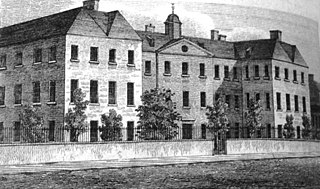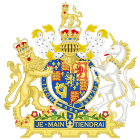
The English Poor Laws were a system of poor relief in England and Wales that developed out of the codification of late-medieval and Tudor-era laws in 1587–1598. The system continued until the modern welfare state emerged after the Second World War.

In Britain and Ireland, a workhouse was an institution where those unable to support themselves financially were offered accommodation and employment. The earliest known use of the term workhouse is from 1631, in an account by the mayor of Abingdon reporting that "we have erected wthn [sic] our borough a workhouse to set poorer people to work".
Prince of Wales was a transport ship in the First Fleet, assigned to transport convicts for the European colonisation of Australia. Accounts differ regarding her origins; she may have been built and launched in 1779 at Sidmouth, or in 1786 on the River Thames. Her First Fleet voyage commenced in 1787, with 47 female convicts aboard, and she arrived at Botany Bay in January 1788. On a difficult return voyage in 1788–1789 she became separated from her convoy and was found drifting helplessly off Rio de Janeiro with her crew incapacitated by scurvy.

The Poor Law Amendment Act 1834 (PLAA) known widely as the New Poor Law, was an Act of the Parliament of the United Kingdom passed by the Whig government of Earl Grey. It completely replaced earlier legislation based on the Poor Relief Act 1601 and attempted to fundamentally change the poverty relief system in England and Wales. It resulted from the 1832 Royal Commission into the Operation of the Poor Laws, which included Edwin Chadwick, John Bird Sumner and Nassau William Senior. Chadwick was dissatisfied with the law that resulted from his report. The Act was passed two years after the Representation of the People Act 1832 which extended the franchise to middle-class men. Some historians have argued that this was a major factor in the PLAA being passed.
A poor law union was a geographical territory, and early local government unit, in Great Britain and Ireland.

In England and Wales, an extra-parochial area, extra-parochial place or extra-parochial district was a geographically defined area considered to be outside any ecclesiastical or civil parish. Anomalies in the parochial system meant they had no church or clergymen and were therefore exempt from payment of poor or church rates and usually tithes. They were formed for a variety of reasons, often because an area was unpopulated or unsuitable for agriculture, but also around institutions and buildings or natural resources. Extra-parochial areas caused considerable problems when they became inhabited as they did not provide religious facilities, local governance or provide for the relief of the poor. Their status was often ambiguous and there was demand for extra-parochial areas to operate more like parishes. Following the introduction of the New Poor Law, extra-parochial areas were effectively made civil parishes by the Extra-Parochial Places Act 1857 and were eliminated by the Poor Law Amendment Act 1868. This was achieved either by being integrated with a neighbouring or surrounding parish, or by becoming a separate civil parish if the population was high enough.
The Roundsman System, in the Poor Relief Act 1601, was a form of organised labour exchange for the poorest labourers by which a parish vestry helped to pay local farmers, households and others to employ such applicants for relief at a rate of headline wages negotiated and set by the parish. It depended not on the services, but on the wants of the applicants: the employers being repaid out of the poor rate all they advanced in wages beyond a very low-wage amount. Variants of the Roundsman system operated and co-existed from parish-to-parish and sometimes depending on type of labour.

The Poor Relief Act 1601 was an Act of the Parliament of England. The Act for the Relief of the Poor 1601, popularly known as the Elizabethan Poor Law, "43rd Elizabeth" or the Old Poor Law was passed in 1601 and created a poor law system for England and Wales.

In English and British history, poor relief refers to government and ecclesiastical action to relieve poverty. Over the centuries, various authorities have needed to decide whose poverty deserves relief and also who should bear the cost of helping the poor. Alongside ever-changing attitudes towards poverty, many methods have been attempted to answer these questions. Since the early 16th century legislation on poverty enacted by the Parliament of England, poor relief has developed from being little more than a systematic means of punishment into a complex system of government-funded support and protection, especially following the creation in the 1940s of the welfare state. Poor relief will control crime if adequately given.

The Union Chargeability Act 1865 was an Act of the Parliament of the United Kingdom that was passed after the Poor Law Amendment Act 1834. The intention of the act was to broaden the base of funding for relief provided by the Poor Laws.

The Metropolitan Poor Act 1867 was an Act of Parliament of the United Kingdom, the first in a series of major reforms that led to the gradual separation of the Poor Law's medical functions from its poor relief functions. It also led to the creation of a separate administrative authority the Metropolitan Asylums Board.
Poor Law policy after the New Poor Law concerns the time period c. 1847–1900 after the implementation of the Poor Law Amendment Act until the beginnings of the decline of the Poor Law system at the start of the 20th century.

The Northern Railroad was a U.S. railroad in central New Hampshire. Originally opened from Concord to West Lebanon in 1847, the Northern Railroad become part of the Boston and Maine system by 1890.

The Erection of Cottages Act 1588 was an Act of the Parliament of England that prohibited the construction—in most parts of England—of any dwelling that did not have at least 4 acres assigned to it out of the freehold or other heritable land belonging to the person responsible for its construction.

The Scottish poorhouse, occasionally referred to as a workhouse, provided accommodation for the destitute and poor in Scotland. The term poorhouse was almost invariably used to describe the institutions in that country, as unlike the regime in their workhouse counterparts in neighbouring England and Wales residents were not usually required to labour in return for their upkeep.
Georgiana was launched in 1791. She served as a merchantman, packet ship for the British East India Company (EIC), a whaler, a warship of the navy of the United States of America, and a merchant vessel again. She was sold after being condemned in 1818 as leaky.

Amelia Wilson was built in France under another name and captured by the British in 1809. Her new owners renamed her and she became a West Indiaman. She later became a whaler and was wrecked in 1833 on her fifth whaling voyage.

The seal of Cincinnati is the official insignia of the city of Cincinnati, Ohio, in the United States. Adopted in 1819, the seal incorporates scales, a sword, and a caduceus. The seal is featured prominently in the flag of Cincinnati and the insignia of city agencies and institutions.
HMS Hazard was launched in 1749 For the Royal Navy as brig-rigged sloop. She had a 30-plus year career with the navy, during which she captured several small French privateers. At the end of the American War of Independence, the navy sold her and she became the merchantman Joseph. After almost a decade as a merchantman trading with Spain, a new owner made a whaler of her. She made seven whaling voyages and was no longer listed after 1804, two years after her return from her last whaling voyage.
Salisbury was built at Havana c.1761 under another name. She first appeared under British ownership in 1781 as a West Indiaman. In 1785 she became the northern whale fishery whaler Rebecca. In 1787 new owners renamed her Harpooner and she was briefly a northern whaler in the Davis Strait. She was wrecked in 1789.












